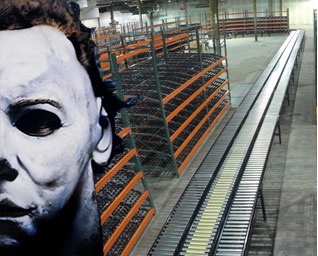Can You Outrun Warehouse & Factory Safety Phantom?
The Spectre of improper safety standards can wreak havoc on a facility, unless you face your fears

You try to run away as fast as you can, aware of the scary apparition chasing you with each breath. You turn to look back, and stumble onto the ground. Paralyzed with fear, you watch as the shape moves closer and closer. Suddenly up close, you can see that there was no way you could escape, as safety issues could not be stopped.
Blumhouse horror movie? Not really. Warehouses can be dangerous places to work in. It is important to understand common warehouse dangers and hazards because they can cause injuries and in extreme cases death, haunting your warehouse for years to come. The US Bureau of Labor Statistics reported an average of 16 fatalities every year in the US warehousing and storage sector and a reported injury and illness rate of 5 out of every 100 warehouse and storage workers. With these ghastly statistics in mind, we review some of the most common warehouse safety bogeymen and offer tips and resources to help you avoid their terror.
Frightening Forklifts
Forklifts are critical pieces of equipment used in warehousing and storage facilities. However, when operated incorrectly can cause serious damage to operators, nearby workers and property. Unsafe use of forklifts is the most often cited hazard in warehousing operations by OSHA. How can you help ensure your facility keeps
- Ensure all forklift operators are competent and have completed certified training
- Perform daily pre-start forklift equipment inspections to check for controls and equipment damage
- In high-traffic situations, employ safety equipment designed to separate forklifts and pedestrians
- Utilize forklift accessories designed to make your equipment more visible and easier to operate
See: A Step-by-Step Safety Process for Forklifts and Pedestrians
Demonic Docks
One of the worst accidents a worker could suffer when working in a warehouse is being pinned or crushed between a forklift truck and the loading dock. This can typically occur when a forklift runs off the dock and strikes a person.
- Forklift operators must be attentive and drive slowly on dock plates, make sure dock edges are clear and safe to support loads
- Always ensure that warning signs and equipment are in place to prevent people from getting near docks
See: OSHA Requirements for Better Loading Dock Fall Protection
Creepy Conveyors
While conveyor equipment is commonly used in warehouse facilities to transport goods fast and efficiently, they can pose serious dangers to workers including getting caught in equipment and being struck by falling objects. To remain safe it is important to:
- Ensure proper safeguarding training between the conveyor and the worker to protect against the entanglement of clothing, body parts and hair.
- Create proper processes for employees to adhere to for safer conveyor operation.
- Follow proper conveyor maintenance and repair procedures to get the most out of your equipment
Scary Storage
Improper stacking of loads and storage of materials in shelves can result in unintended slip and trip hazards for nearby workers. Combat these ghastly ghouls with the following:
- Install rack protection on your most vulnerable areas for damage
- Reduce rack flue space obstruction for safer ventilation
- Loads should be placed evenly and properly positioned, heavier loads must be stacked on lower or middle shelves.
- Train your employees on the importance of moving one load at a time
See: What Causes a Pallet Rack Collapse? How Can You Prevent It?
Eerie Ergonomics
The most common cause of physical injuries in warehouse and storage facilities involves improper manual lifting and handling. Manual lifting or handling can cause musculoskeletal disorders if done with awkward postures, repetitive motions, or overexertion (like running from a ghost or goblin!).
- Determine if an area would be better suited for lift tables or workstations to increase proper worker ergonomics
- Use lift trucks can help reduce the amount of physical stress a worker will use daily
- Observe proper ergonomic posture when carrying or moving loads
Harrowing Hazardous Chemicals
When handling hazardous chemicals in your warehouse or storage facilities, a hazard communication program should be implemented. Your hazard communication program should cover effective training on identifying chemical hazards, proper handling, storage, and disposal of chemicals, and the use of appropriate PPE.
If safety procedures and workplace hazards are disregarded in warehouses to cut costs, it exposes workers to serious dangers of accidents and injury. Proper training, consistent safety inspections and utilizing the right equipment can help maintain a safe and secure environment, while avoiding the dreaded safety bogeyman that lurks around every corner.
Discover the Cisco-Eagle Difference
You have plenty of options when searching for an organization to help you build, expand or enhance your facility. Download our guide to find out why we’re different and how our service and support set us apart from other material handling providers.
Download the guide today
Evan Fleishacker




